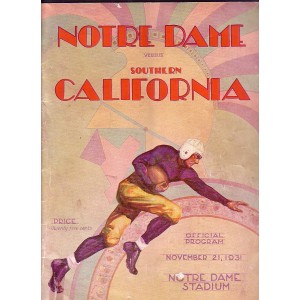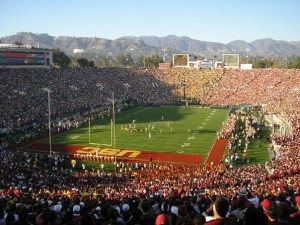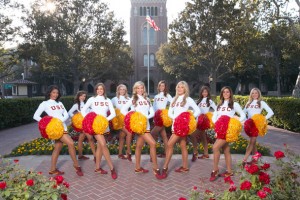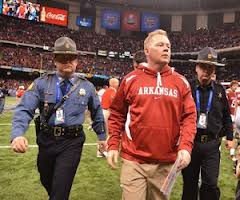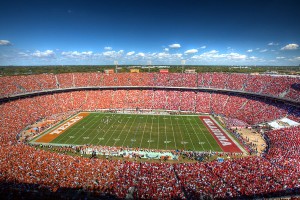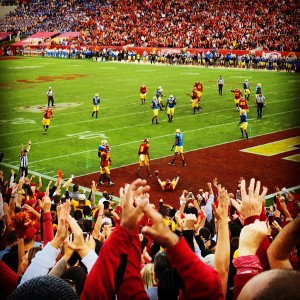
Taylor McNamara’s TD catch capped off USC’s South Division-clinching 40-21 victory over UCLA on Nov. 28
Welcome to my third and final monthly recap of my 2015 “Picking the Winners” Pac-12 preview (which has appeared annually on USCFootball.com for the past decade or so). My first two recaps appeared on Sept. 30 (covering September results) and Nov. 5 (covering October results). If you missed my picks in the feature story, here’s the link:
15th Annual ‘Picking the Winners’ Pac-12 Preview
My November mark of 18-7 (including the Pac-12 Championship game) left my overall record for the season at 67-25 (.728), matching my 2014 mark. Not counting the Pac-12 title game — which I include as a loss, since I had Oregon (not Stanford) beating USC (hmm, on second thought, should I count the North champ over USC as a win?) — half of my defeats came at the hands of a Washington State team that closed out a surprising 8-4 season. Before taking a look at the season overall, let’s see how things shook out in November — my best picks, worst picks, and how my preseason expectations for each team compared with the reality.
Week 10
Best Picks
- USC over Arizona (picked 42-27; actual 38-30)
- Oregon over California (picked 57-28; actual 44-28)
Worst Pick
- Arizona State over Washington State, 41-31 (actual: Washington State 38, Arizona State 24)
- Washington over Utah, 22-20 (actual: Utah 34, Washington 23)
A 4-2 week was marred by, of course, Washington State’s home win against the Sun Devils — after falling behind 14-0 early — and Utah‘s victory over Washington. My best picks of the week narrowly missed being even better, as the Trojans (picked by 15 over Arizona) allowed a meaningless late touchdown after leading, 38-23. And while Oregon allowed 28 points to California (as predicted), the Ducks’ offense was still finding its way a bit.
Week 11
Best Picks
- Oregon over Stanford (picked 30-24; actual 38-36)
- California over Oregon State (picked 52-31; actual 54-24)
- Arizona State over Washington (picked 38-23; actual 27-17)
Worst Pick
- UCLA over Washington State, 48-22 (actual: Washington State 31, UCLA 27)
For the fourth time in 2015, I enjoyed a one-loss week, going 5-1. Unsurprisingly, it was the Cougars who kept me from my first perfect week of the season when they scored with three seconds to play at UCLA. Among the five winners, Oregon’s “upset” at Stanford was perhaps the most surprising after how the season’s first 10 weeks had played out. Meanwhile, my pick of Cal scoring 50+ in a blowout over Oregon State came true, and I missed the correct margin by just five points in Arizona State‘s win against the Huskies.
Week 12
Best Picks
- Oregon over USC (picked 45-35; actual 48-28)
- Arizona State over Arizona (picked 41-34; actual 52-37)
- Stanford over California (picked 42-20; actual 35-22)
Worst Picks
- Oregon State over Washington, 19-17 (actual: Washington 52, Oregon State 7)
- Colorado over Washington State, 33-30 (actual: Washington State 27, Colorado 3)
- Utah over UCLA, 26-16 (actual: UCLA 17, Utah 9)
The weekend of Nov. 21 tied for my toughest of the season (3-3). Incredibly, I picked the week’s marquee matchup (Oregon-USC) and two rivalry games (the Territorial Cup and the Big Game) correctly, while failing on what seemed to be less attractive games . The Beavers continued to somehow be worse than I imagined. And Washington State’s demolition of Colorado toppled one of my preseason upset picks.
Week 13
Best Picks
- California over Arizona State (picked 45-42; actual 48-46)
- Utah over Colorado (picked 31-19; actual 20-14)
Worst Pick
- Washington over Washington State, 28-27 (actual: Washington, 45-10)
I never would have imagined that my only perfect week of 2015 would coincide with the last full slate of the year — especially considering the number of rivalry games, what became a huge Stanford-Notre Dame matchup, and a back-and-forth shootout in Berkeley. But not only did I go 6-0 — meaning that I ended up picking all five traditional conference rivalry outcomes correctly in 2015 — but I also just missed the final score in Cal’s “Pac-12 After Dark” win over ASU.
Week 14
Pac-12 Championship: Stanford 41, USC 22 (picked Oregon over USC, 38-31)
Honestly, after what the Trojans faced during the first month-and-a-half of the 2015 campaign, I’m as stunned as you are that I picked the South Division champion correctly.
November Expectations vs. Reality
With six incorrect picks in regular season games, once again there’s plenty of shakeup when looking at my expectations for each squad. As usual, let’s start from the Pacific Northwest and head down the coast before curling back inland.
- Washington (picked 2-2, 2-2 in Pac-12; reality 2-2, 2-2): Overachieving Utah and underachieving Oregon State (even with limited expectations) helped me fail on two Husky picks.
- Washington State (picked 0-4, 0-4 in Pac-12; reality 3-1, 3-1): The Cougars’ surprise season was reflected in three appearances in my “Worst Picks of the Week” column in November.
- Oregon State (picked 1-3, 1-3 in Pac-12; reality 0-4, 0-4): My only miss on Oregon State in November: picking them to beat Washington at home. Instead, the Huskies led 45-0 at halftime.
- Oregon (picked 4-0, 4-0 in Pac-12; reality 4-0, 4-0): My preseason pick of the Ducks as dominant finally came to fruition in a month where UO beat Stanford on the road and whipped USC in Eugene.
- California (picked 2-2, 2-2 in Pac-12; reality 2-2, 2-2): For a second consecutive month, I nailed all four Cal game predictions.
- Stanford (picked 3-1, 3-1 in Pac-12; reality 3-1, 3-1): Not counting Stanford’s appearance in the Pac-12 title game (replacing my preseason pick, Oregon), I notched four correct calls on the Cardinal.
- UCLA (picked 2-2, 2-2 in Pac-12; reality 2-2, 2-2): While the pick vs. reality looks good, I shanked two Bruins’ picks, with Washington State’s improvement and Utah’s loss of Devontae Booker biting me.
- USC (picked 3-1, 3-1 in Pac-12; reality 3-1, 3-1 ): A perfect four-for-four (five-for-five, if you want to count the Trojans’ loss in the Pac-12 championship game).
- Arizona State (picked 3-1, 3-1 in Pac-12; reality 2-2, 2-2): Yep, Washington State again.
- Arizona (picked 1-2, 1-2 in Pac-12; reality 1-2, 1-2): A perfect month of Wildcat selections.
- Utah (picked 2-2, 2-2 in Pac-12; reality 2-2, 2-2): More muddled results with my Ute picks, missing their Washington and UCLA outcomes.
- Colorado (picked 1-3, 1-3 in Pac-12; reality 0-4, 0-4): Those Cougs did it to me — and the Buffs — again.
2015 Pac-12 Picks: The Final Breakdown
If you’re still with me, here’s a look back at the full season results, in comparison to my preseason picks, with errors noted.
North Division (by order of finish)
- Stanford: Final record — 11-2, 8-1; preseason prediction — 10-2, 7-2 (second in North). Variance: lost at Northwestern; won at USC; advanced to and won Pac-12 Championship game vs. USC.
- Oregon: Final record — 9-3, 7-2; preseason prediction — 12-1, 9-0 (first in North). Variance: lost vs. Utah; lost vs. Washington State; failed to advance to Pac-12 Championship game.
- Washington State: Final record — 8-4, 6-3; preseason prediction — 3-9, 1-8 (sixth in North). Variance: lost vs. Portland State; won at Rutgers; won at Oregon; won at Arizona; won vs. Arizona State; won at UCLA; won vs. Colorado.
- California: Final record — 7-5, 4-5; preseason prediction — 6-6, 4-5 (third in North). Variance: won at Texas.
- Washington: Final record — 6-6, 4-5; preseason prediction — 4-8, 2-7 (fifth in North). Variance: won at USC; won vs. Arizona; lost vs. Utah; won at Oregon State.
- Oregon State: Final record — 2-10, 0-9; preseason prediction — 4-8, 2-7 (fourth in North). Variance: lost vs. Colorado; lost vs. Washington.
South Division (by order of finish)
- USC: Final record — 8-5, 6-3; preseason prediction — 10-3, 7-2 (first in South). Variance: lost vs. Stanford; won at Arizona State; lost vs. Washington; lost at Notre Dame.
- Utah: Final record — 9-3, 6-3; preseason prediction — 7-5, 4-5 (fifth in South). Variance: won at Oregon; won vs. Arizona State; won at Washington; lost vs. UCLA.
- UCLA: Final record — 8-4, 5-4; preseason prediction — 8-4, 5-4 (fourth in South). Variance: won at Arizona; lost vs. Arizona State; lost vs. Washington State; won at Utah.
- Arizona State: Final record — 6-6, 4-5; preseason prediction — 8-4, 6-3 (second in South). Variance: lost vs. USC; won at UCLA; lost at Utah; lost at Washington State.
- Arizona: Final record — 6-6, 3-6; preseason prediction — 8-4, 5-4 (third in South). Variance: lost vs. UCLA; won at Colorado; lost vs. Washington State; lost at Washington.
- Colorado: Final record — 4-9, 1-8; preseason prediction — 6-7, 2-7 (sixth in North). Variance: lost at Hawaii; lost vs. Arizona; won at Oregon State; lost at Washington State.
In the North, I was two points from picking California’s entire season correctly. Yes, I picked Texas to beat Cal by a point — but it was the Bears who pulled off a 45-44 win, saddling me with my only incorrect selection on the Berkeley schedule. Additionally, I missed only two outcomes each on the schedules of North stalwarts Stanford and Oregon.
Unsurprisingly, my worst set of results featured Washington State, which I picked to finish in the North cellar. I failed in picking seven of the Cougs’ 12 outcomes, but one of those has to be on them — their season-opening loss to FCS-level Portland State.
Intriguingly, I had exactly four incorrect selections for all six South Division clubs, while picking the division winner (USC) correctly. However, with some minor shuffling behind the Trojans, I correctly picked five South squads for bowl eligibility.
2015 Pac-12 Bowl Picks
Finally, with a record 10 conference clubs reaching the postseason, here are my picks for each bowl, with the slate getting underway tomorrow (College Football Playoff rankings reflected).
Saturday, Dec. 19
- Gildan New Mexico Bowl, Albuquerque: Arizona 41, New Mexico 30
- Royal Purple Las Vegas Bowl, Las Vegas: (22) Utah 23, BYU 21
Saturday, Dec. 26
- Hyundai Sun Bowl, El Paso: Miami 35, Washington State 31
- Zaxby’s Heart of Dallas Bowl, Dallas: Washington 31, Southern Mississippi 21
- Foster Farms Bowl, Santa Clara: UCLA 38, Nebraska 27
Tuesday, Dec. 29
- Lockheed Martin Armed Forces Bowl, Fort Worth: California 42, Air Force 28
Wednesday, Dec. 30
- National Funding Holiday Bowl, San Diego: (25) USC 24, Wisconsin 20
Friday, Jan. 1, 2016
- Rose Bowl Game presented by Northwestern Mutual, Pasadena: (6) Stanford 30, (5) Iowa 24
Saturday, Jan. 2, 2016
- Valero Alamo Bowl, San Antonio: (15) Oregon 43, (11) TCU 37
- Motel 6 Cactus Bowl, Phoenix: West Virginia 34, Arizona State 31
Thanks for reading. I look forward to being back for the 2016 season!

